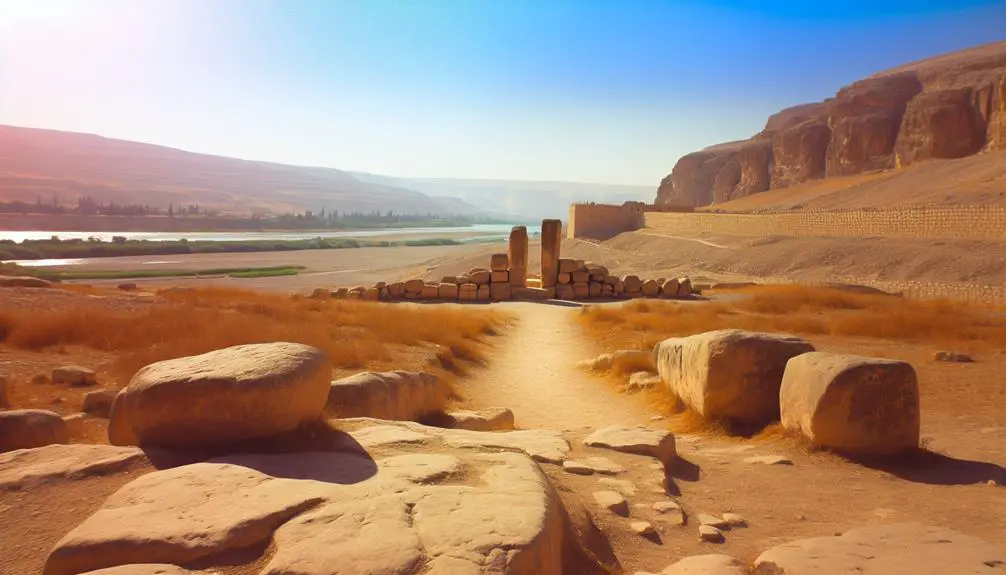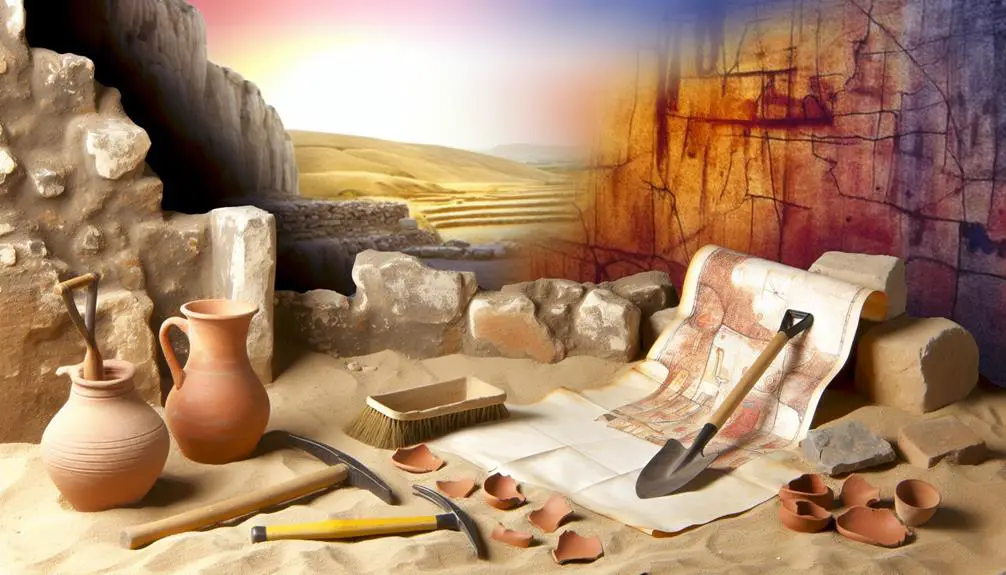Mysteries of Gilgal unfold in the Bible, revealing its pivotal role in Israel's journey and spiritual heritage—discover its hidden significance.

Meaning of Gilgal in the Bible
Like a gem hidden in plain sight, Gilgal holds a place of significant mystery and importance in the biblical narrative that you might not have fully appreciated. As you explore its origins, its role in the stories of the Israelites, and its symbolic meanings, you'll uncover layers of history and faith that are as intriguing as they are enlightening.
Gilgal isn't just a geographical location; it's a touchstone for events that shaped the journey of a nation and its relationship with the divine. To grasp the full scope of its impact, you'll need to look beyond the surface, where a deeper understanding awaits.
Key Takeaways
- Gilgal signifies the Israelites' transition into the Promised Land and their covenant renewal.
- It embodies spiritual symbolism of transitions, renewal, and divine encounters.
- Events at Gilgal, such as the Jordan crossing and Passover celebration, mark pivotal biblical narratives.
- Modern excavations at Gilgal enhance understanding of its historical and religious context.
The Origins of Gilgal

Gilgal's origins, deeply embedded within biblical history, reveal its significance as the first encampment of the Israelites after crossing the Jordan River into the Promised Land. The etymology of Gilgal contributes profoundly to understanding its role and meaning in early Israelite culture. The term 'Gilgal' is believed to be derived from the Hebrew word 'galgal,' translating to 'circle of stones' or 'wheel.' This etymological insight not only offers a glimpse into the physical appearance of the site but also underscores its ceremonial and memorial functions.
The geographic location of Gilgal plays a pivotal role in its historical and religious significance. Situated near the Jordan River's eastern banks, it served as a strategic point for the Israelites entering Canaan. This location wasn't chosen arbitrarily; its proximity to the Jordan River was crucial for both practical and symbolic reasons, facilitating the passage of a whole nation and symbolizing a new beginning in the Promised Land.
Analyzing Gilgal's origins through the lenses of its etymology and geographic location provides a deeper understanding of its foundational role in Israelite history and culture, emphasizing its significance beyond just a mere encampment.
Gilgal in Biblical Narratives
You'll find that Gilgal's emergence in biblical narratives isn't merely incidental but pivotal to understanding Israel's spiritual and physical journey.
Its first appearance marks a significant transition, embedding Gilgal deeply in the fabric of Israelite history and memory.
This analysis underscores Gilgal's multifaceted role, demonstrating its importance beyond a mere geographical location.
Gilgal's First Appearance
In biblical narratives, Gilgal first emerges as a pivotal location during the Israelites' entrance into the Promised Land, marking a significant moment in their collective journey.
You'll find that Gilgal's location isn't merely a geographical detail but holds profound significance in the unfolding biblical saga.
Situated east of Jericho, Gilgal becomes the first encampment of the Israelites in Canaan, symbolizing a bridge between their wilderness wanderings and the realization of divine promise.
This geographical positioning is instrumental, for it underscores Gilgal's role as a threshold, a point of transition and transformation for the Israelite community.
Its strategic location near the Jordan River further emphasizes its significance as a place of renewal and covenant reaffirmation for the nation.
Significance in Israel's Journey
Throughout its biblical narratives, Gilgal serves as a crucial stage in Israel's journey, encapsulating moments of transition, conquest, and covenantal renewal. This location isn't merely a geographical waypoint but a theological and historical landmark.
- Circumcision Ceremony: Marks Israel's renewed covenant with God, signifying their rebirth as a nation dedicated to the divine mission.
- Camp Establishment: Serves as the initial campsite for Israel after crossing the Jordan River, symbolizing a new beginning.
- Strategic Military Base: Gilgal becomes a pivotal point for launching conquests into the Promised Land.
- Covenantal Renewal Site: Reaffirms Israel's commitment to God's laws and commandments.
- Prophetic Encounters: Plays a role in narratives involving significant prophetic figures, reinforcing its spiritual significance.
In essence, Gilgal is a multifaceted symbol of Israel's identity, faith, and divine purpose.
Symbolism of Gilgal

You must grasp that Gilgal serves as more than a mere geographical location within the biblical narrative; it embodies a profound spiritual symbolism and marks pivotal moments in Israel's history.
Its representation stretches beyond physical space, signifying transitions, renewal, and divine encounters. Understanding Gilgal's multifaceted symbolism offers you deeper insights into its historical and spiritual significance within the biblical context.
Gilgal's Spiritual Significance
Gilgal's spiritual significance in the Bible transcends its physical location, serving as a powerful symbol of transformation and renewal for believers. This site, known for its circular encampments, has been a focal point for renewal rituals, playing a pivotal role in the spiritual journey of the Israelites. Its symbolism is rich and multifaceted:
- Represents the Israelites' transition from wilderness to Promised Land.
- Symbolizes the shedding of past burdens and sins.
- Marks the beginning of a new covenant relationship with God.
- Encourages believers to remember and celebrate God's deliverance and faithfulness.
- Serves as a reminder of the importance of obedience and consecration in one's spiritual journey.
Through these symbols, Gilgal stands as a testament to the enduring power of faith and transformation in the believer's life.
Gilgal in Israel's History
Building on its spiritual significance, we now explore how Gilgal has been woven into the fabric of Israel's history, embodying symbolism that is both profound and pivotal. The Gilgal location is not just a geographical point but a cornerstone in understanding the evolution of Israelite identity. Archaeological debates have enriched our comprehension of Gilgal, challenging and deepening our interpretations of its role.
Aspect |
Significance |
|---|---|
Archaeological Debates |
Illuminate the complexity of Gilgal's past. |
Geographical Location |
Anchors Gilgal's historical and spiritual narratives. |
Cultural Symbolism |
Represents renewal and the unbroken bond between the divine and Israel. |
Historical Events |
Gilgal is pivotal in recounting Israel's transition from nomadism to statehood. |
This analysis underscores Gilgal's multifaceted role in Israel's collective memory, reflecting its continual importance across epochs.
Gilgal and the Israelites
Marking a pivotal moment in their history, the Israelites first encamped at Gilgal as they entered the Promised Land, setting the stage for its profound biblical significance. This locale wasn't just another stopover; it was the circumcision site that symbolized their covenant renewal with God. Furthermore, the establishment of their camp at Gilgal marked a transition from a nomadic to a settled existence, reflecting a significant evolution in their identity.
- Circumcision site: A physical and spiritual act of covenant, reinforcing their commitment to God.
- Camp establishment: Marked the beginning of Israel's transition from wandering in the desert to establishing a foothold in Canaan.
- Strategic location: Positioned near Jericho, Gilgal was crucial for military and logistical purposes.
- Symbol of renewal: Represented a fresh start, leaving behind the old ways and embracing a new identity.
- Center for worship: Became a focal point for religious observance and community gatherings.
Gilgal's role in this phase of Israelite history can't be understated. It served as a multifaceted symbol of their faith, resilience, and unity, laying a solid foundation for the challenges and triumphs that lay ahead.
Miracles and Events

Reflecting on the foundational significance of Gilgal in Israelite history, it's essential to examine the miraculous events and noteworthy occurrences that further underscore its biblical importance. Gilgal's geography, positioned as a liminal space between wilderness and promise, served not only as a physical entry point into the Promised Land but also as a theological threshold, marking moments of covenant renewal and divine intervention.
One such event, the miraculous crossing of the Jordan River, occurred near Gilgal. Here, the Israelites witnessed the waters part as they carried the Ark of the Covenant, reminiscent of the Red Sea crossing. This miracle underscored Gilgal's role as a space where the natural and supernatural converge, reinforcing the Israelites' faith in God's continued presence and protection.
Moreover, Gilgal became a site for covenant renewal. It was here that Joshua erected stones taken from the Jordan's bed as a memorial to their crossing, and the Israelites celebrated the Passover, signifying their transition from wandering nomads to a people with a land. The circumcision of the new generation at Gilgal symbolized their renewal of the covenant with God, reiterating Gilgal's significance in Israel's spiritual landscape.
Prophetic Encounters at Gilgal
Gilgal's biblical narrative further deepens with the occurrence of significant prophetic encounters, serving as a pivotal arena for divine messages and guidance. This site symbolizes a threshold, not only geographically but spiritually, marking transitions and transformations within the prophetic tradition. Here, the fabric of Israel's spiritual journey is interwoven with profound encounters, each echoing the depth of divine engagement with humanity.
Consider these pivotal moments:
- Elijah's Departure: Gilgal stands as the starting point of Elijah's final journey before his miraculous ascension, underlining its role as a space of divine transition and revelation.
- Elisha's Inheritance: It was from Gilgal that Elisha inherits a double portion of Elijah's spirit, symbolizing the passing of prophetic authority and the continuation of divine work through new generations.
- The place served as a spiritual epicenter where the mantle of leadership and spiritual authority was transferred.
- Gilgal's association with these events underscores its significance in the prophetic narrative, acting as a backdrop for divine appointment and empowerment.
- The site exemplifies the dynamic interplay between divine promise, prophetic fulfillment, and the ongoing journey of faith.
Gilgal's role in these narratives highlights its importance in understanding the evolution of prophetic ministry and the deep, enduring connection between place, memory, and divine encounter.
Archaeological Insights

Turning our focus to archaeological insights, we find evidence that further elucidates Gilgal's multifaceted role in biblical history. Excavation techniques have evolved, allowing archaeologists to uncover layers of the past with greater precision. They've unearthed structures, pottery, and tools that shed light on the daily lives and spiritual practices of those who inhabited Gilgal. Through meticulous artifact preservation, these findings offer a tangible connection to biblical narratives, reinforcing the site's historical and religious significance.
Advanced excavation methods, such as stratigraphy and radiocarbon dating, have played a crucial role in piecing together Gilgal's timeline. These techniques enable scholars to date artifacts and structures accurately, providing a chronological framework that aligns with biblical accounts. The preservation of these artifacts involves careful cleaning, cataloging, and analysis, ensuring that each piece contributes to our understanding of Gilgal's history.
This archaeological endeavor isn't just about uncovering the past; it's a bridge to understanding the socio-political and religious dynamics of ancient societies. As you delve into the layers unearthed at Gilgal, you're not just encountering relics; you're piecing together a narrative that brings biblical stories to life, offering insights into the ancient world that shaped these sacred texts.
Gilgal's Modern Significance
In today's context, Gilgal holds a profound significance, serving as a vital link between ancient biblical history and contemporary religious and cultural identity. This place, steeped in historical and spiritual resonance, continues to inspire and engage people across the globe. Modern Gilgal doesn't just exist as a geographical location or an archaeological site; it thrives in the hearts and minds of those who seek to connect with their faith and heritage.
Here's how Gilgal's significance unfolds in the modern era:
- Gilgal festivals: Annual celebrations that bring communities together, fostering a sense of unity and shared heritage.
- Educational tours: Schools and religious groups often visit modern Gilgal to connect with their spiritual roots.
- Archaeological interest: Researchers and historians continue to explore Gilgal to uncover further insights into its historical context.
- Spiritual retreats: Individuals and groups seek out Gilgal for contemplation and spiritual renewal.
- Cultural events: Gilgal serves as a backdrop for various cultural activities that highlight its historical and religious importance.
Modern Gilgal stands as a testament to the enduring legacy of biblical narratives, bridging centuries and cultures, and inviting exploration and reflection.
Frequently Asked Questions
How Has the Interpretation of Gilgal's Meaning Evolved in Different Christian Denominations Over Time?
You've seen Gilgal's meaning evolve across Christian denominations, showcasing interpretive diversity. Initially, denominational symbolism played a minor role, but over time, as theological perspectives widened, so did interpretations.
Now, Gilgal embodies various theological concepts, from renewal to judgment, differing significantly among denominations. This evolution reflects broader trends in biblical interpretation, where context, tradition, and contemporary issues influence understanding, leading to a rich tapestry of meanings within the Christian faith.
Are There Any Lesser-Known Myths or Legends Involving Gilgal Outside the Canonical Bible Texts?
You're about to uncover myths that could turn the sands of time. Beyond the canonical texts, Gilgal's legends intertwine with rituals and archaeological debates, painting a rich tapestry of history and belief.
These stories, though lesser-known, are pivotal, offering deep insights into ancient practices and theological perspectives. They challenge and enrich our understanding, proving that Gilgal's significance stretches far beyond its biblical roots, into realms both debated and revered.
How Do Contemporary Jewish Scholars and Communities View or Commemorate Gilgal Today?
Today, you'll find that contemporary Jewish scholars and communities view Gilgal with a mix of historical reverence and symbolic interpretation.
They don't typically engage in Gilgal rituals, but they deeply explore its layers through community interpretations, linking it to themes of renewal and transformation.
This scholarly analysis enriches understanding, ensuring that Gilgal's significance is both preserved and dynamically engaged with in modern Jewish thought and practice.
What Are the Environmental and Geographical Changes Around the Historical Site of Gilgal Noted by Scientists or Historians Over the Centuries?
Over the centuries, the area around Gilgal has undergone significant environmental and geographical transformations. A startling statistic reveals that nearly 30% of the original landscape has been altered due to climate impact.
Archaeological findings support this, showing shifts in soil composition and vegetation patterns that mirror these changes.
As you delve into the scientific and historical analyses, you'll notice how these shifts not only document environmental evolution but also challenge the preservation of historical sites.
How Has Gilgal Been Represented or Referenced in Modern Literature, Art, or Media Outside of Religious Texts?
In modern culture, Gilgal's influence extends beyond religious texts, seeping into literature, art, and media.
Artists and writers have drawn inspiration from its rich history, resulting in various Gilgal sculptures and adaptations. These works not only honor its historical significance but also reinterpret its legacy in contemporary contexts.
Through these creative endeavors, Gilgal continues to resonate, showcasing its enduring impact on collective memory and artistic expression.
Conclusion
In conclusion, Gilgal holds a multifaceted significance in biblical narratives, serving as a pivotal location for Israelite history, spiritual symbolism, and prophetic encounters. Archaeological endeavors have begun to peel back layers of its storied past, offering tangible connections to its biblical mentions.
Interestingly, among the various sites mentioned in the Bible, Gilgal stands out with over a dozen references, underscoring its profound impact on Israelite heritage. This reinforces Gilgal's enduring legacy, bridging ancient texts with contemporary understanding, and inviting further scholarly exploration.



Sign up